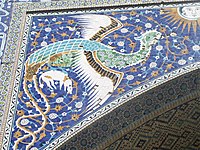Lab-i Hauz (Uzbek: Labihovuz, Tajik: Лаби Ҳавз, romanized: Labi Havz, Persian: لب حوض, romanized: Lab-e Howz, meaning in Persian "by the pool"), sometimes also known as Lyab-i Khauz, a Russian approximation, is the name of the area surrounding one of the few remaining hauz pools that have survived in the city of Bukhara, Uzbekistan. Until the Soviet period, there were many such pools, which were the city's principal source of water, but they were notorious for spreading disease and were mostly filled in during the 1920s and 1930s.
The Lab-i Hauz survived because it is the centerpiece of a magnificent architectural ensemble, created during the 16th and 17th centuries, which has not been significantly change...Read more
Lab-i Hauz (Uzbek: Labihovuz, Tajik: Лаби Ҳавз, romanized: Labi Havz, Persian: لب حوض, romanized: Lab-e Howz, meaning in Persian "by the pool"), sometimes also known as Lyab-i Khauz, a Russian approximation, is the name of the area surrounding one of the few remaining hauz pools that have survived in the city of Bukhara, Uzbekistan. Until the Soviet period, there were many such pools, which were the city's principal source of water, but they were notorious for spreading disease and were mostly filled in during the 1920s and 1930s.
The Lab-i Hauz survived because it is the centerpiece of a magnificent architectural ensemble, created during the 16th and 17th centuries, which has not been significantly changed since. The Lab-i Hauz ensemble, surrounding the pool on three sides, consists of the Kukeldash Madrasah (1568–1569, the largest madrasa in the city), on the north side of the pool, and two religious edifices built by Nadir Divan-Beghi: a khanqah (1620; Uzbek: xonaqah, meaning a lodging house for itinerant Sufis) and a madrasa (1622), which stand on the west and east sides of the pool respectively. The small Qāzī-e Kalān Nasreddīn madrasa (now demolished) was formerly located beside the Kukeldash madrasah.
 Simurgh on the portal of Nadir Divan-Beghi madrasah (part of Lab-i Hauz complex)
Simurgh on the portal of Nadir Divan-Beghi madrasah (part of Lab-i Hauz complex)The history of this ensemble is closely connected with the name of Nadir Divan-Beghi, who was an important grandee, vizier, and also an uncle of the Emir of Bukhara Imam Quli Khan. It is said that when Nadir Divan-Beghi built the khanqah which bears his name, near the site of the building there was a large holding owned by an old Jewish widow. (There was a substantial population of Bukharan Jews.) Nadir Divan-Beghi had decided that this site would be the perfect place for a pool, but the widow turned down his offer to buy the property. Then Nadir Divan-Beghi brought her before Imam Quli Khan in the hope that the Emir would coerce her into selling. The Emir of Bukhara ordered a congress of muftis to inquire into the question. However, these specialists in Muslim law decided that there was no legal way to purchase the property, other than with the widow's consent, since Jews had rights on a par with Muslims if they paid the Jizya or poll-tax on non-Muslims.
So, Nadir Divan-Beghi had to build a small reservoir near the house of that stubborn Jew. But he dug an aryk, an irrigation ditch, to his new pool in such a way that the water ran right near her house, although it was more expensive. Soon the water began to undermine the foundations of the widow's house. When she came to Nadir Divan-Beghi for justice, he confirmed his readiness to buy her house for a fair price. But widow rejected the money, laying down her own conditions instead. She promised give up her property if the Bukharan rulers would give to her another piece of land with permission to build a synagogue. In return for the widow’s holding Nadir Divan-Beghi gave her a plot of land, belonging to him, in a residential area, which later was named the Jewish quarter (Mahalli Kuma).
Soon the first synagogue at Bukhara and a large pool were built. People started to call it Lab-i Hauz (see picture), which means in Persian "by the pool". The date of its construction is about 1620. But folk memory still retains another epithet – Hauz-i Bazūr, "pool made with force".



























Add new comment